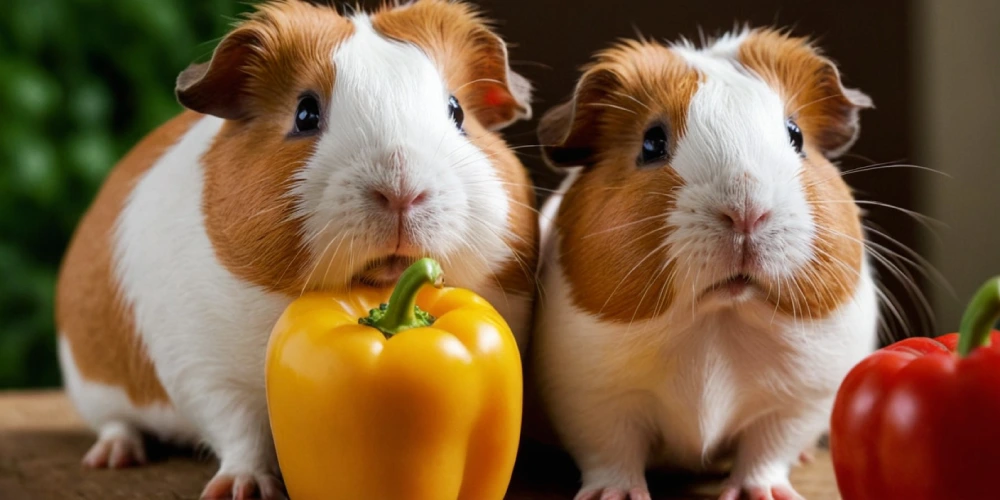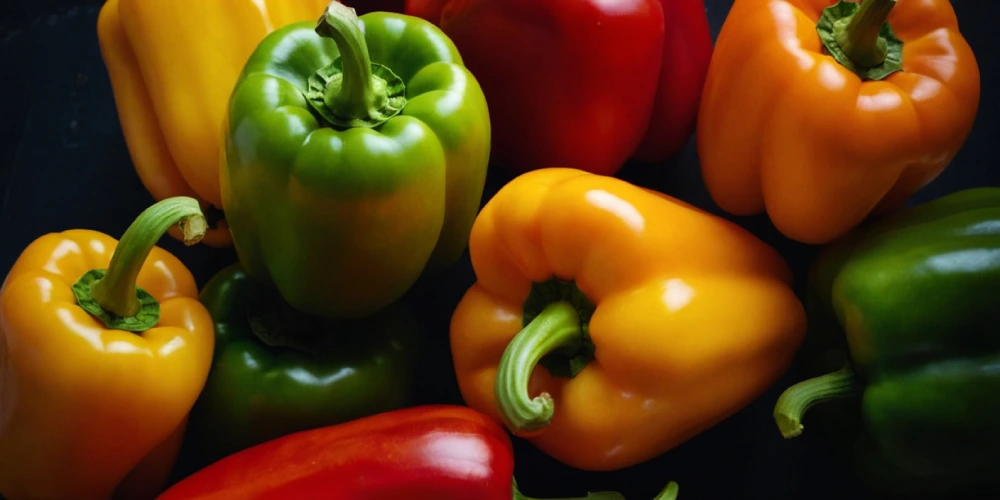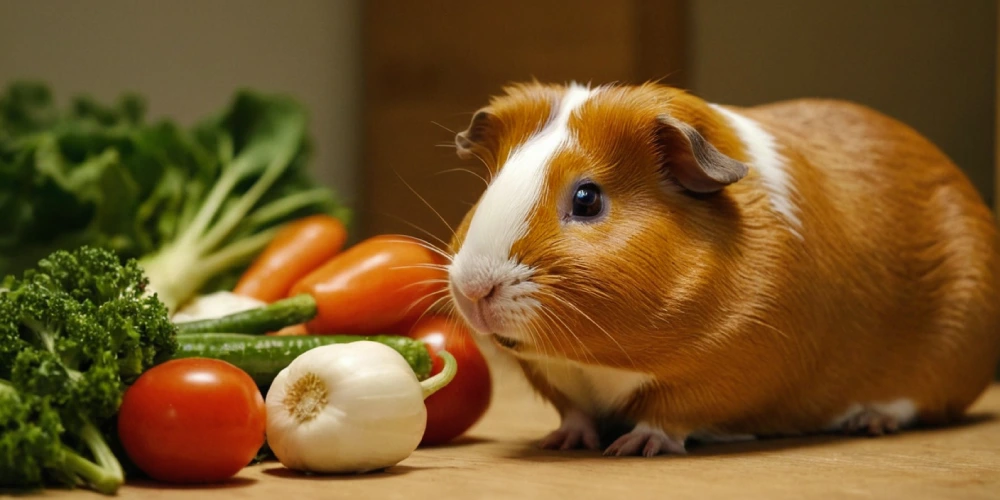
Many pet owners are curious about which fruits and vegetables are safe to serve to their guinea pigs. The question, “Can guinea pigs eat bell peppers?” is frequently asked. Bell peppers, well-known for their vivid hues and high vitamin content, are a healthy option for people, but can guinea pigs also eat them?
Because guinea pigs cannot synthesize vitamin C alone, bell peppers are a great source of this vital component. They can avoid deficits and maintain their general health by including foods high in vitamin C. Some bell pepper hues may be better for your pet than others, though, and not all of their portions are safe. In this article, we’ll explore the benefits of feeding bell peppers to guinea pigs, the recommended serving sizes, and any potential risks to ensure a healthy diet for your little companion.
Can Guinea Pigs Eat Bell Peppers? Everything You Need to Know
Adorable, gregarious pets, such as guinea pigs, have nutritional requirements that support their general well-being. Many guinea pig owners wonder if bell peppers are safe to feed their pets and how best to include them in a balanced diet. In this article, we’ll discuss everything you need to know about feeding bell peppers to guinea pigs, including their benefits, how much to feed, and the best ways to serve them.
Understanding Guinea Pig Dietary Needs
Basic Nutritional Requirements of Guinea Pigs
Their diet must be rich in Vitamin C, fiber, and hydration to keep guinea pigs healthy. Guinea pigs need to eat foods high in vitamin C because they cannot create them independently. Guinea pigs who don’t get enough vitamin C may get scurvy, which causes symptoms like joint pain, decreased appetite, and general weakness.
Fiber is also crucial, supporting digestion and ensuring their sensitive gastrointestinal systems stay in good shape. Fresh hay and certain vegetables are excellent sources of fiber that help guinea pigs maintain regular digestion and prevent issues like bloating. Finally, hydration is vital, as guinea pigs need fresh water daily to stay healthy and avoid kidney issues.
Importance of a Balanced Diet in Guinea Pig Health
A balanced diet prevents common health issues in guinea pigs, such as obesity, dental problems, and digestive issues. Their primary diet should consist of hay, a small portion of high-quality pellets, and various fresh vegetables. Including different vegetables in their diet gives them various nutrients and keeps mealtime exciting. Remember that balance is essential for your guinea pig’s health when introducing new foods like bell peppers.
Nutritional Profile of Bell Peppers for Guinea Pigs
Essential Nutrients in Bell Peppers
Vitamin C, an essential ingredient for guinea pigs, is abundant in bell peppers. They are also rich in other essential nutrients, including potassium, magnesium, fiber, and antioxidants. Bell peppers are low in calories, making them a great addition to your guinea pig’s diet without the risk of weight gain.
Health Benefits of Bell Peppers for Guinea Pigs
Adding bell peppers to your guinea pig’s diet can benefit their immune system due to the high Vitamin C content. Additionally, the fiber in bell peppers promotes healthy digestion and supports the guinea pig’s sensitive digestive system. Bell peppers are also mostly water, which helps keep your guinea pig hydrated. When offered in moderation, these qualities make bell peppers a nutritious and hydrating treat for your pet.

Types of Bell Peppers: Which Are Safe for Guinea Pigs?
Red, Yellow, Green, and Orange Bell Peppers – What’s the Difference?
Each type of bell pepper has a different flavor and nutrient profile:
- Red bell peppers are the sweetest and highest in Vitamin C, making them an excellent choice for guinea pigs.
- Yellow bell peppers: Similar to red, yellow peppers also have a high Vitamin C content and a mildly sweet taste.
- Green bell peppers have a slightly lower Vitamin C level and a more bitter flavor. Although still safe, they may be less appealing to guinea pigs.
- Orange bell peppers are close in flavor to yellow peppers and offer Vitamin C, making them a safe option.
Choosing the Best Type of Bell Pepper for Your Guinea Pig
All bell peppers are safe for guinea pigs. Still, red and yellow peppers are generally the most beneficial due to their high Vitamin C content and sweet taste. Green bell peppers are an option, but less sweet and less appealing. Offering a variety of colors can keep your guinea pig interested in their diet.
Can Guinea Pigs Eat Bell Pepper Seeds and Stems?
Potential Risks of Bell Pepper Seeds and Stems
While bell pepper flesh is safe, the seeds and stems can pose a risk. Seeds are small and hard, creating a potential choking hazard for guinea pigs. They are also harder to digest and can lead to gastrointestinal discomfort. Stems are fibrous and difficult to chew, which increases the risk of choking and digestive issues.
Safe Preparation Tips for Bell Peppers
Remove the seeds and stems from bell peppers before feeding them to your guinea pig to reduce dangers. Cut the pepper into small, bite-sized pieces to make it easier for them to chew and digest. Always wash the bell peppers thoroughly to remove pesticides or other residues, ensuring your guinea pig gets a clean and safe treat.

Portion Sizes and Frequency: How Much Bell Pepper is Safe?
Recommended Serving Sizes Based on Guinea Pig Age and Size
A small slice of bell pepper given a few times per week for adult guinea pigs is generally safe. Younger or smaller guinea pigs should receive even smaller portions to avoid digestive issues. Introducing bell peppers gradually and watching for any signs of stomach discomfort will ensure they enjoy this treat safely.
Frequency of Feeding Bell Peppers
Bell peppers should not replace the guinea pig’s regular diet of hay and leafy greens. Instead, offer bell peppers two to three times a week to add variety and provide essential vitamins without overloading their diet with sugar.
Health Risks of Feeding Bell Peppers to Guinea Pigs
Possible Side Effects and Allergies
While bell peppers are safe, some guinea pigs might experience digestive discomfort or show signs of an allergic reaction. Symptoms like bloating, diarrhea, or reduced appetite could indicate that your guinea pig doesn’t tolerate bell peppers well. Monitor their health after introducing this food to ensure they don’t experience any adverse reactions.
High Sugar Content in Bell Peppers
Bell peppers contain natural sugars, especially in red and yellow varieties. While this sweetness can be appealing, too much sugar can cause weight gain or stomach upset in guinea pigs. Moderation is essential to avoid these risks, so stick to the recommended portion sizes.
Introducing Bell Peppers to Your Guinea Pig’s Diet
Gradual Introduction and Observation
Start with a small piece and observe your guinea pig’s reaction when introducing bell peppers. The gradual introduction helps prevent digestive upset and allows you to monitor how well they tolerate this new food. Watch for any signs of discomfort, and if your guinea pig shows a positive response, you can slowly increase the portion size within safe limits.
Monitoring for Signs of Intolerance or Allergy
Suppose your guinea pig exhibits symptoms like diarrhea, bloating, or lethargy after eating bell peppers. In that case, they may not tolerate this food well. If you see any of these signs, discontinue feeding bell peppers and consult a veterinarian if symptoms persist.
Alternative Vegetables for Guinea Pigs
Leafy Greens and Vegetables High in Vitamin C
In addition to bell peppers, several other vegetables are healthy for guinea pigs and high in vitamin C. Kale, Broccoli, spinach, and parsley are significant options that can provide additional nutrients without adding excess sugar. These leafy greens are excellent for balancing their diet and ensuring they get enough essential vitamins.
Low-Sugar Vegetables for Balanced Nutrition
To maintain a balanced diet, consider adding cucumber, zucchini, and celery, which are low in sugar and provide hydration and fiber. These vegetables are great options for guinea pigs who need a lower-sugar diet or have sensitive digestive systems.
Conclusion
Bell peppers can be a nutritious and enjoyable addition to a guinea pig’s diet when offered in moderation. Their high Vitamin C content and natural hydration benefits make them an ideal treat for guinea pigs, especially red and yellow varieties. By removing seeds and stems, cutting peppers into bite-sized pieces, and offering them sparingly, you can safely introduce bell peppers into your guinea pig’s diet, adding variety and supporting their overall health.
Frequently Asked Questions (FAQs)
1.Can guinea pigs eat bell peppers every day?
No, it’s best to offer bell peppers in moderation, about two to three times per week, to avoid excess sugar and ensure a balanced diet. Daily feeding can lead to digestive issues and may affect your guinea pig’s health.
2.Are all colors of bell peppers safe for guinea pigs?
All bell pepper hues are suitable for guinea pigs; red and yellow peppers are usually the best options because of their high vitamin C content and sweet taste.
3.How can I tell if my guinea pig likes bell peppers?
Guinea pigs often show their enjoyment through excited sounds, quick nibbling, and positive reactions. If your guinea pig happily eats the bell pepper and seems eager for more, it’s a good sign they enjoy it.
4.What are other Vitamin C-rich foods I can feed my guinea pig?
Other safe, Vitamin C-rich options include kale, parsley, and small amounts of strawberries or oranges (in moderation due to sugar content).
5.What should I do if my guinea pig shows signs of an allergic reaction?
You should immediately cease feeding bell peppers and get guidance from a veterinarian if you observe signs such as swelling, itching, or trouble breathing.
